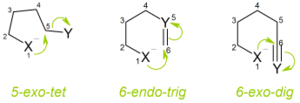
Baldwin's rules
Encyclopedia

Organic chemistry
Organic chemistry is a subdiscipline within chemistry involving the scientific study of the structure, properties, composition, reactions, and preparation of carbon-based compounds, hydrocarbons, and their derivatives...
are a series of guidelines outlining the relative favourabilities of ring closure reactions in alicyclic compounds. They were first proposed by Jack Baldwin in 1976.
The rules classify ring closures in three ways:
- the number of atoms in new ring formed
- into exo and endo ring closures, depending whether the bond broken during the ring closure is inside (endo) or outside (exo) the ring which is formed
- into tet, trig and dig, depending whether the electrophilic carbon is tetrahedral/sp3 (tet), trigonal/sp2, (trig) or digonal/sp, (dig)
Thus, a ring closure reaction could be classified as, for example, a 5-exo-trig.

Baldwin discovered that orbital
Molecular orbital
In chemistry, a molecular orbital is a mathematical function describing the wave-like behavior of an electron in a molecule. This function can be used to calculate chemical and physical properties such as the probability of finding an electron in any specific region. The term "orbital" was first...
overlap requirements for the formation of bonds favour only certain combinations of ring size and the exo/endo/dig/trig/tet parameters.
There are sometimes exceptions to Baldwin's rules. For example, cations often disobey Baldwin's rules, as do reactions in which a second-row atom is included in the ring.
| Baldwin dis/favoured ring closures | ||||||||||
|---|---|---|---|---|---|---|---|---|---|---|
| |colspan="2"|3 | 4 | 5 | 6 | 7 | ||||||
| type | exo | end | exo | end | exo | end | exo | end | exo | end |
| tet | √ | √ | √ | X | √ | X | √ | |||
| trig | 00 | X | √ | X | √ | X | √ | √ | √ | √ |
| dig | X | √ | X | √ | √ | √ | √ | √ | √ | √ |
The rules apply when the nucleophile can attack the bond in question in an ideal angle. These angles are 180° for exo-tet reactions, 109° for exo-trig reaction and 120° for endo-dig reactions.
Applications
In one study seven-membered rings were constructed in a tandem 5-exo-dig addition reactionAddition reaction
An addition reaction, in organic chemistry, is in its simplest terms an organic reaction where two or more molecules combine to form a larger one....
/ Claisen rearrangement
Claisen rearrangement
The Claisen rearrangement is a powerful carbon-carbon bond-forming chemical reaction discovered by Rainer Ludwig Claisen...
:
A 6-endo-dig pattern was observed in a allene
Allene
An allene is a compound in which one carbon atom has double bonds with each of its two adjacent carbon centres. Allenes are classified as polyenes with cumulated dienes. The parent compound of allene is propadiene. Compounds with an allene-type structure but with more than three carbon atoms are...
- alkyne
Alkyne
Alkynes are hydrocarbons that have a triple bond between two carbon atoms, with the formula CnH2n-2. Alkynes are traditionally known as acetylenes, although the name acetylene also refers specifically to C2H2, known formally as ethyne using IUPAC nomenclature...
1,2-addition / Nazarov cyclization tandem catalysed by a gold
Gold
Gold is a chemical element with the symbol Au and an atomic number of 79. Gold is a dense, soft, shiny, malleable and ductile metal. Pure gold has a bright yellow color and luster traditionally considered attractive, which it maintains without oxidizing in air or water. Chemically, gold is a...
compound :
A 5-endo-dig ring closing reaction was part of a synthesis of (+)-Preussin
The Baldwin rules also apply to aldol cyclizations involving enolates :
The rules are the following:
| Dis/favored ring closures for enolates | ||||||||||
|---|---|---|---|---|---|---|---|---|---|---|
| |colspan="5"|enolendo | enolexo | |||||||||
| type | 3 | 4 | 5 | 6 | 7 | 3 | 4 | 5 | 6 | 7 |
| exo-tet | X | X | X | √ | √ | √ | √ | √ | √ | √ |
| exo-trig | X | X | X | √ | √ | √ | √ | √ | √ | √ |


